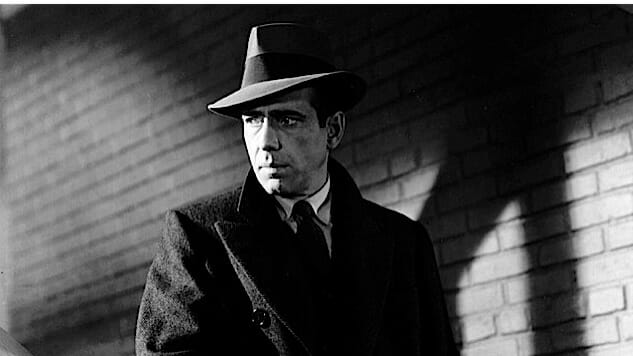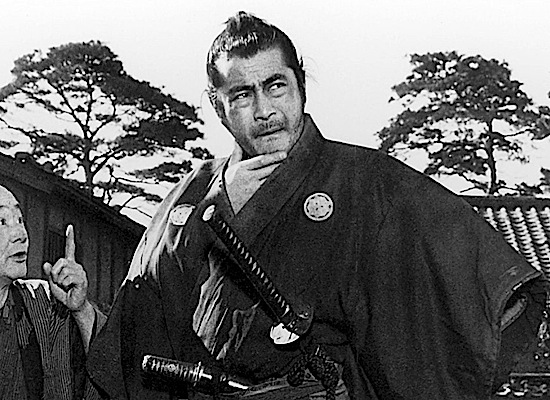Nobody’s Son: The Legacy of Dashiell Hammett
Dashiell Hammett’s detective fiction inspired the cinematic anti-heroes of the East and West
Movies Features westerns
“Here we are, weakly caught in the middle, and it is impossible to choose between evils. Myself, I’ve always wanted to somehow or other stop these senseless battles of bad against bad, but we’re all more or less weak – I’ve never been able to. And that is why the hero of this picture is different from us. He is able to stand squarely in the middle and stop the fight.”
—Akira Kurosawa on his film Yojimbo
“The cheaper the crook, the gaudier the patter.”
—The Maltese Falcon, by Dashiell Hammett
Anybody can lapse into a parody of film noir or detective fiction almost on command. The deadpan worldview and gut-punch prose of the genre have long since joined the song “Born To Be Wild” among things that used to be revolutionary and now exist only to lampoon themselves. When kid-friendly productions like A Prairie Home Companion and Calvin & Hobbes can play with the grim postwar private eye, we can conclude it has lost its edginess.
But despite that, I don’t think a lot of people actually engage with the original work. Bill Watterson himself admitted to not having really read any of the detective stories that Calvin’s Tracer Bullet character spoofs.
“Tracer Bullet stories are extremely time-consuming to write, so I don’t attempt them often. I’m not at all familiar with film noir or detective novels, so these are just spoofs on the clichés of the genre,” he wrote in The Tenth Anniversary Book of Calvin and Hobbes.
It’s too bad. Before it was done to death, the hardest of hardboiled detective fiction inspired numerous touchstones of 20th century cinema’s treatises on the fatalistic pride of the Wounded Male Anti-Hero. A lot of it began with one thin, sickly man with a pencil mustache.
When Toshiro Mifune or Clint Eastwood or Humphrey Bogart stride into a hopeless fight with only their grit and our belief that they’ve just got to win, they’re many times following the dance steps of largely forgotten crime writer Dashiell Hammett.
![]()
“Who shot him?” I asked.
The gray man scratched the back of his neck and said: “Somebody with a gun.”
—Red Harvest, by Dashiell Hammett
A man (usually a man) rolls into a dust-choked town that looks like little more than a hole in the ground. We don’t know who he is, but we sense he’s dangerous. The casual cruelty of this town is put on display somehow: A dog runs by with a man’s severed hand in its jaws in Yojimbo (1961), a dead man with a sign tacked to his back rides out of town on the back of a horse in A Fistful of Dollars (1964).
Akira Kurosawa, Yojimbo’s director and the father of the samurai picture, cited Hammett’s work as an influence on his story of a ronin who rolls into town to find two violent gangs fighting for dominance. In Kurosawa’s treatment of the story, it’s an utterly pointless struggle: The town is anemic, the fight itself just posturing between two groups that want nothing more than to be in charge. The nameless, master-less samurai strokes his chin and muses that there’s money to be made in this forsaken place.
Many people know that Kurosawa influenced the “Spaghetti Western” films of Sergio Leone—A Fistful of Dollars is a beat-for-beat adaptation of Yojimbo—but what’s often lost in that conversation is what respect Kurosawa had for Western literature and film to begin with.
“Westerns have been done over and over again, and in the process, a kind of grammar has evolved,” Kurosawa is quoted in Donald Richie’s The Films of Akira Kurosawa. “I have learned from this grammar of the Western.”

Kurosawa cited a 1942 film adaptation of Hammett’s novel The Glass Key as an inspiration on Yojimbo as well, but it’s a curious thing to cite (apart from one torture scene that very clearly mirrors samurai Sanjuro’s ordeals). The Glass Key’s plot doesn’t mirror Yojimbo’s in the slightest, while the plot of another Hammett novel, Red Harvest, is nearly the exact same story. Equally curiously, Red Harvest was only ever adapted loosely, into the 1930 film Roadhouse Nights.
It can’t just be coincidence, though. In Hammett’s novel, a short, pugnacious detective from the fictional Continental Detective Agency rolls into the California mining town of Personville (pointedly mispronounced “Poisonville” at times), witnesses the aftermath of a murder, and decides to take money to reclaim the town from the thuggish strikebreakers and vice lords whose fights with one another have turned the streets into a war zone. Like Kurosawa’s samurai and Leone’s poncho-wearing gunman, Hammett’s Continental Op character smirks as he openly gives people a false name, and proceeds to play both ends against the middle in a desperate game that he could end at any time by simply walking away. Fascinatingly, we don’t want him to.
All three plots—Red Harvest, Yojimbo and A Fistful of Dollars —feature frequent switching of allegiance, corrupt (or completely absent) police, daring gambits that see the protagonist facing down armed adversaries, and a final showdown that sees the two wicked forces gripping the town abandoning the uneasy peace that allowed them to keep thieving and murdering with impunity so they can descend completely into the bestial self-destruction that was there all along.

We’re meant to believe the hero has done this because of money and opportunism, but there are stirrings of humanity and even bruised morality hidden inside him along the way—usually that result in him getting beaten bloody. After the two sides have completely killed one another—after we have seen the logical conclusion of “bad against bad”—our hero rolls out of town. We know nothing more about him than we did when he came in—beyond what we read into his actions ourselves. The arc of the story is not his, but the town’s.
The only real difference between them is that Hammett’s bloody original is at least nominally interested in uncovering the circumstances of a murder. It isn’t even right to say “solve” a murder, since the Op clearly isn’t going forward under the assumption that he’s going to bring anybody to justice in the end.
![]()
To really get at the heart of how deeply Hammett’s work got under the skin of the cinematic imagination, it’s worth taking a look at the man who crafted the novel in the first place. Hammett’s life was in some ways as lurid and dark as the characters of his body of work.
Born in 1894 in Maryland, Samuel Dashiell Hammett’s tuberculosis spared him from the World War I draft, but it’s doubtful the thin young man appreciated it. He joined the Pinkerton detectives in 1915, just as the rise of organized labor saw the agency become the infamous private army of choice for corporate leaders hoping to bust unions. He infiltrated labor unions and informed on them for his bosses, but if he thought of himself as a total mercenary, his actions belied it: In Dark City: The Lost World of Film Noir, Eddie Muller recounts a time when Hammett was offered $5,000 to kill union leader Frank Little. When Hammett declined, somebody else stepped in to do the dirty deed instead.
It would completely reorient his political sensibilities for the rest of his life. Hammett would go on to become an outspoken Communist—outspoken enough that his participation in one group that raised bail money to try to free 11 high-profile political activists ended with his pleading the fifth on the stand and landing in jail for contempt of court. At night, he would join his fellow inmates and listen to a radio show starring the character Sam Spade—hero of The Maltese Falcon, the novel which Hammett himself wrote.
In essence, Hammett wrote the 1941 screenplay to the film adaptation, too: The director instructed his secretary to take the book and simply turn it into a screenplay. Much of the dialogue and story between the two are, as a result, almost completely unchanged. Humphrey Bogart’s roles, time and again, would mirror that same sort of protagonist: World-weary and formidable, but wounded underneath.
Hammett might have been principled, but he wasn’t a saint. Biographer Sally Cline writes in Dashiell Hammett: Man of Mystery that his physical infirmity left him deeply insecure, and he would drink, use and abuse women physically and emotionally, and generally be an absent husband and father. Despite this, he still had relationships with his daughters, and though the last years of his life were a crushing descent into alcoholism and writer’s block, even his longtime (and long-suffering) companion Lillian Hellman saw fit to care for him in his last four miserable years. In eulogizing him, she said of his earlier imprisonment that “he had come to the conclusion that a man should keep his word.”
Is it a wonder that the characters his works have inspired—violent, opportunistic, and cynical as they are—still seem to cling to some essential morality beneath it all?
Even the propensity of the samurai and cowboy characters who sprung up in his wake to go about unnamed is textbook Hammett: He once signed his name “Peter Collinson,” or “Nobody’s Son,” from the carnie slang “Peter Collins,” which meant a nobody. Cline wrote that he rarely ever signed correspondence with his given name, preferring “Sam” or “Dash.” The Continental Op who mean-mugged and bluffed and punched his way through many of Hammett’s stories never once gives his name out—a “Peter Collins” himself. It’s another telling little detail about the man who would become the father of the cinematic Man With No Name.
![]()
Viewed just as a literary landmark, Hammett’s work signaled a shift in detective fiction from the school of Poe or Doyle’s impossible locked room mysteries, and toward a world-weariness and grit that rose out of the modern megalopolises that were rising in the early 20th-century United States.
“Most detective stories that emerged from [that period] followed this pattern,” Muller wrote. “They had less to do with intricate plots and feats of deduction than they did with the tarnished chivalry and jaundiced attitude of the detective.”
That’s what cinema latched onto. In Red Harvest, as in Yojimbo and A Fistful of Dollars—and in all the dark and mighty works that truly understand them as an inspiration—tarnished chivalry is what the story is truly about. The hero is an opportunist and a jerk, but will you look at these bad guys? The world is a better place without them, even if it means upending the uneasy calm of the place they prey upon. Peace that lets evil strut the streets is no peace at all. We’re powerless and meek in the horrible battle of bad against bad. Somewhere inside us, there’s the mad urge to punish the wicked, even if it means burning down the world rather than letting the unrighteous have the run of it.
Hammett was a man with wounded pride and an acidic view of a world whose darker corners he’d seen up close and in Technicolor. It’s ironic but not surprising that the work of a slight and in some ways insecure man would give rise to stories and performances that are the definition of cinematic masculinity: Humphrey Bogart’s deadpan snark, Toshiro Mifune’s swaggering stride, Clint Eastwood’s heart-freezing glare.
And it makes perfect sense that, compared to the iconic bad men he inspired, his own name largely remains in the shadows.
Kenneth Lowe is a media relations coordinator for state government in Illinois. His work has appeared in Colombia Reports, Illinois Issues magazine, and the St. Louis Post-Dispatch.